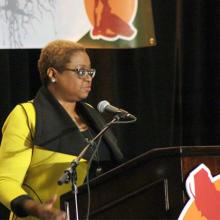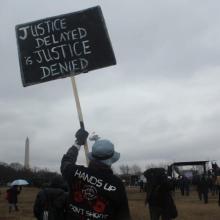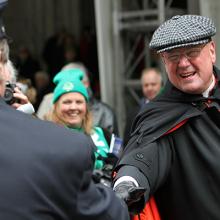march
March is the most underrated month. In it, winter makes room for spring in a million miraculous ways. These changes are imperceptible unless you slow down and pay attention.
This Saturday, people across the country will come together digitally to demand action from public officials as part of the Mass Poor People’s Assembly & Moral March on Washington.
Hundreds of furloughed federal employees chanting "we want to work" gathered for a union-led march to the White House on Thursday, the 20th day of a partial government shutdown over U.S. President Donald Trump's demand for border wall funding.
"Hey, hey, ho, ho, shutdown's got to go" protesters shouted as they assembled in the bitter cold outside of the AFL-CIO union headquarters, hoisting signs reading "Trump: End the Shutdown," "Reopen Govt" and "Let Me Do My Job."
The People's Assembly responded in a statement that they were campaigning against an American-style healthcare system that is "expensive, inefficient and unjust.
"We believe that this pardon does not contribute to the process of national reconciliation because it turns its back on the victims and because it is the product of apparent pact of impunity. We believe that without sincere repentance and without meeting the expectation of justice and reparation for those whose rights were trampled an authentic reconciliation cannot exist and cannot be achieved."
In the aftermath of a Oct. 14 truck bombing that killed over 300 people in Mogadishu, Somalia, thousands of people took to the capital's streets in response to mayor Thabit Abdi's call to unity, according to The Guardian.
The Rev. Leah Daughtry stood in front of fellow black Christian leaders and told them they will need to work harder for social justice.
“If you’ve been feeding them, now clothe them,” said the Pentecostal pastor and 2016 CEO of the Democratic National Convention Committee at a conference last week. “If you’ve been clothing them, now console them. If you’ve been at a march, now lead the march. If you’ve been at a rally, now organize the rally.”
On Jan. 21, I’ll join thousands in D.C. for the Women’s March on Washington. My first stop will be at a local congregation, one of several hosting a prayer service and warming station for marchers. I’m an anti-racist, feminist, Christian, and for me, faith will be part of the day.
I’ve been disappointed with Christian silence, and even active resistance, to social justice imperatives, but my commitments to justice stem from my faith, and that’s why I march.
Crying out “no justice, no peace,” crowds joined the Rev. Al Sharpton in a weekend march towards the Martin Luther King Jr. Memorial, vowing not to let President-elect Donald Trump turn back strides made by the civil rights leader.
The mostly African-American throng — smaller than the thousands expected, due to the steady rain — heard from civic and religious leaders about key areas of concern: health care, voting rights, economic equality, and police brutality and reform.
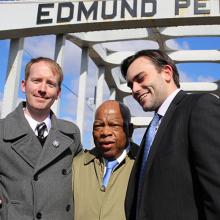
Left to right, Nate Powell, Rep. John Lewis, and Andrew Aydin. Image via Sandi Villarreal / Top Shelf Productions / RNS
Q: Representative Lewis, in an earlier book of this series we read that you were asked by church leaders to tone down your speech at the 1963 March on Washington. How does March: Book Three deal with issues of faith?
Lewis: Book Three tells a story how people kept going, how people never gave up or gave in, in spite of the bombing of a church, the beating on the bridge as we had left church to march all the way from Selma to Montgomery. We kept going, we never gave up, we never gave in, we never became bitter or hostile. We kept the faith. It was the music of the church that lifted us, that carried us. … We felt like God Almighty was on our side.

Image via We Belong Together/Facebook
In the past six days, I’ve walked 75 miles alongside 100 other women. We have 25 miles left to go.
We are 100 women who hail from all four corners of the earth. There are women from Uganda, China, Mexico, Haiti, the Philippines, Mexico, El Salvador, Argentina, Brazil, Vietnam, Peru, the Bahamas, and more. But we all call this country home.
Several grandmothers joined us on this journey, and their perseverance is an example for all of us. Our youngest walker is Jocelyn — she is four years old, and her joy is contagious. We all ask to take turns pushing her stroller. As we walk, we share our stories, our suffering, and our dreams. We sing, we pray, and we also walk in silence — reflecting on our faith, the meaning of compassion, dignity, and hope.
We are all here because we have been inspired by Pope Francis’ message of love and compassion towards migrants and refugees. We hope that he will pray for the 11 million undocumented immigrants who endure daily hardship, living in fear of deportation and family separation. We hope that he can touch the hearts of Americans across the nation to treat migrants with compassion and not cruelty.
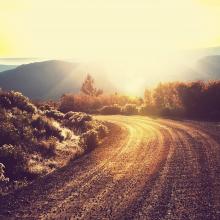
Image via Galyna Andrushko/Shutterstock
In the face of wars, refugee crises, weapon proliferation, and unaddressed climate change impacts, let us echo the common sense of children. Let goodness shine.
Or, as our young friends in Afghanistan have put it, #Enough! They write the word, in Dari, on the palms of their hands and show it to cameras, wanting to shout out their desire to abolish all wars.
This past summer, collaborating with Wisconsin activists, we decided to feature this refrain on signs and announcements for a 90-mile walk campaigning to end targeted drone assassinations abroad, and the similarly racist impunity granted to an increasingly militarized police force when they kill brown and black people within the U.S.
Cardinal Timothy Dolan’s positive reaction to this week’s decision by organizers of New York’s annual St. Patrick’s Day parade to allow gay groups to march under their own banners initially drew charitable responses in many Catholic Church circles.
But it didn’t take long for conservative church critics to turn.
After initially signaling his grudging acceptance, William Donohue of the Catholic League came back with a revised view when he realized that more than one gay group could be allowed to march in the future.
“The goal of these activists, supported by the corporate elite, is to neuter the religious element of the parade,” Donohue said. “This is an Irish-Catholic parade, and if what comes after the hyphen is cut, so will the parade’s support, beginning with the Catholic League.”
Saturday marked the third time since Israel began military operations in Gaza on July 8 that I let my voice be heard. I stood and marched alongside some 20,000 other individuals that like me have become utterly disgusted by what is unfolding in the Middle East.
A cease-fire has been struck, but as of yesterday, at least 1,800 Palestinians, most of whom are civilians, have been killed and nearly 7,000 have been wounded. Another 200,000 have been displaced in a territory whose infrastructure is now in ruins with mass power and water outages.
Despite the horrific events that have happened halfway across the world, the protest last Saturday, which took place at the White House, was a beautiful sight. Among the 20,000 protesters were Muslims, Jews, and Christians. There were blacks, whites, Arabs, Asians, and Latinos. There were women and men, both young and old, who had come from cities like Chicago, Tampa, Baltimore, and Boston. Many barriers were broken as we stood and marched in solidarity with the people of Palestine.
There were times when my heart was completely broken as I saw signs with photos of dead and mutilated bodies and others that listed the names and ages of children who had been killed by Israeli airstrikes. But in those same moments I would look across the sea of protesters draped in black, white, green, and red yelling phrases such as "Free, Free Palestine!" and "Stop the killing, stop the hate!" and I would once again become a prisoner of hope. I take refuge in the rock that is Christ Jesus. I know my God stands with those being oppressed, with those seeking justice and peace. I know my voice and prayers along with millions of others around the world will be heard.
Although I am pro-Palestine, that does not make me pro-Hamas or anti-Israel. I recognize and condemn Hamas's involvement in the failed peace talks and inability to find solutions. I also mourn equally for the loss of life on the Israeli side. However, despite the part Hamas has played in all of this I do not find Israel's actions to be justified. So I march.
Environmental activist Bill McKibben took part in the July 5-6 Healing Walk, a spiritual gathering in northern Alberta, Canada, focused on the destruction—to the immediate environment and to the climate itself— caused by tar sands oil extraction and the Keystone XL pipeline across the U.S.
TO WALK, SLOWLY, across the tar sands complex of Alberta is to see our real-life equivalent of The Lord of the Rings’ Mordor. It really is as bad as everyone says. On this one eight-mile loop, we saw vast stretches of muskeg turned into dry, sandy desert; we saw dry-sandy desert that had been further converted into inky tailings lakes; and we were never out of earshot of the cannon that fire all day and all night to keep ducks from landing in the toxic waters. This goes on forever. The most comprehensive way to see it is from the air, I guess, but the best way to feel it is on foot.
Especially if you’re walking with the people who know this land best—have known it for thousands of years. Each year since 2010, local First Nations groups have organized a Healing Walk through the tar sands, and this year’s fourth iteration was by far the largest. Hundreds of people from around the continent camped for several days in a stretch of nearby boreal forest, held workshops and ceremonies, and then emerged for the hike through the industrial barrens.
It may have taken a little bit of prodding — a little ‘you-want-me-to-do-what?’ and a lot of faith — but in the end, Congressman John Lewis agreed to go along with staffer Andrew Aydin’s out-of-the-box idea. The result: March (Book 1) — the first of a three-part graphic novel autobiography chronicling Lewis’ life and the Civil Rights Movement.
“The story of the movement that we tell is very much John Lewis’ story in this first book,” Aydin said. “It is a story of him growing up poor, on a farm, and it builds to a climax of the national sit-in movement.”
Lewis certainly has a lot to tell. He and other activists famously were beaten by police on the Edmund Pettus Bridge in Selma, Ala., in 1965 during an attempted march for voting rights — an event that became known as “Bloody Sunday.” He served as chairman of the Student Nonviolent Coordinating Committee during the height of the movement, spoke at the historic March on Washington alongside Dr. Martin Luther King, Jr., and was instrumental in the passage of the Voting Rights Act of 1965.
Aydin, who co-wrote the book with Congressman Lewis, and illustrator Nate Powell sat down with Sojourners to explain how the series came about and why it is such an important story these 50 years later.
On Wednesday, July 10th, when most eyes were on the private GOP meeting where republicans gathered in the Capitol basement to strategize on immigration reform in the House, advocates were rallying outside House buildings to urge members to enact immigration reform.
Uncertain of what the next steps are in the House, hundreds of activists, families, and faith leaders all gathered proudly and united in front of the Cannon and Longworth House Office Buildings as they chanted loudly, “Si se puede!”
Not discouraged by the hot summer heat, marchers hoped to catch GOP members as they ended their internal meeting and walked back to their offices.
Sojourners' CEO Jim Wallis visited Chicago's North Park University today to march with students, faculty, and staff to form a “Human Circle of Protection” at the North Park Friendship Center. Jim shared his thoughts with Covenant Media Services after the march.
"We are saying, 'God is watching how you decide to cut a deficit,'" Wallis said." A deficit is a moral issue. But how we cut it — what we do, who suffers, who bears the pain of it — is a moral issue too."
Watch video of Jim's intervirew with Covenant Media inside.
Hundreds of miners, activists, students, academics, environmentalists, and other citizens are marching to West Virginia's historic Blair Mountain in an effort to save it from mountaintop removal.






